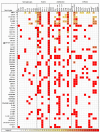Characterization of Shiga Toxin Subtypes and Virulence Genes in Porcine Shiga Toxin-Producing Escherichia coli
- PMID: 27148249
- PMCID: PMC4838603
- DOI: 10.3389/fmicb.2016.00574
Characterization of Shiga Toxin Subtypes and Virulence Genes in Porcine Shiga Toxin-Producing Escherichia coli
Abstract
Similar to ruminants, swine have been shown to be a reservoir for Shiga toxin-producing Escherichia coli (STEC), and pork products have been linked with outbreaks associated with STEC O157 and O111:H-. STEC strains, isolated in a previous study from fecal samples of late-finisher pigs, belonged to a total of 56 serotypes, including O15:H27, O91:H14, and other serogroups previously associated with human illness. The isolates were tested by polymerase chain reaction (PCR) and a high-throughput real-time PCR system to determine the Shiga toxin (Stx) subtype and virulence-associated and putative virulence-associated genes they carried. Select STEC strains were further analyzed using a Minimal Signature E. coli Array Strip. As expected, stx 2e (81%) was the most common Stx variant, followed by stx 1a (14%), stx 2d (3%), and stx 1c (1%). The STEC serogroups that carried stx 2d were O15:H27, O159:H16 and O159:H-. Similar to stx 2a and stx 2c, the stx 2d variant is associated with development of hemorrhagic colitis and hemolytic uremic syndrome, and reports on the presence of this variant in STEC strains isolated from swine are lacking. Moreover, the genes encoding heat stable toxin (estIa) and enteroaggregative E. coli heat stable enterotoxin-1 (astA) were commonly found in 50 and 44% of isolates, respectively. The hemolysin genes, hlyA and ehxA, were both detected in 7% of the swine STEC strains. Although the eae gene was not found, other genes involved in host cell adhesion, including lpfAO113 and paa were detected in more than 50% of swine STEC strains, and a number of strains also carried iha, lpfAO26, lpfAO157, fedA, orfA, and orfB. The present work provides new insights on the distribution of virulence factors among swine STEC strains and shows that swine may carry Stx1a-, Stx2e-, or Stx2d-producing E. coli with virulence gene profiles associated with human infections.
Keywords: Escherichia coli; STEC; Shiga toxins variants; swine; virulence genes.
Figures

Similar articles
-
Characterization of Shiga toxin-producing Escherichia coli isolated from healthy pigs in China.BMC Microbiol. 2014 Jan 6;14:5. doi: 10.1186/1471-2180-14-5. BMC Microbiol. 2014. PMID: 24393167 Free PMC article.
-
Virulence profiles of Shiga toxin 2e-producing Escherichia coli isolated from healthy pig at slaughter.Vet Microbiol. 2006 Oct 31;117(2-4):328-32. doi: 10.1016/j.vetmic.2006.06.017. Epub 2006 Jul 26. Vet Microbiol. 2006. PMID: 16872761
-
Shiga Toxin-Producing Escherichia coli in Feces of Finisher Pigs: Isolation, Identification, and Public Health Implications of Major and Minor Serogroups†.J Food Prot. 2021 Jan 1;84(1):169-180. doi: 10.4315/JFP-20-329. J Food Prot. 2021. PMID: 33411931
-
Role of Verocytotoxigenic Escherichia Coli in the Swine Production Chain.Ital J Food Saf. 2015 Jun 29;4(2):5156. doi: 10.4081/ijfs.2015.5156. eCollection 2015 May 28. Ital J Food Saf. 2015. PMID: 27800398 Free PMC article. Review.
-
A Comprehensive Review on Shiga Toxin Subtypes and Their Niche-Related Distribution Characteristics in Shiga-Toxin-Producing E. coli and Other Bacterial Hosts.Microorganisms. 2024 Mar 28;12(4):687. doi: 10.3390/microorganisms12040687. Microorganisms. 2024. PMID: 38674631 Free PMC article. Review.
Cited by
-
Genome Sequences of 34 Shiga Toxin-Producing Escherichia coli Isolates from Swine and Other Sources.Genome Announc. 2017 Nov 2;5(44):e01214-17. doi: 10.1128/genomeA.01214-17. Genome Announc. 2017. PMID: 29097467 Free PMC article.
-
Genomic analysis of Shiga toxin-producing Escherichia coli O157:H7 from cattle and pork-production related environments.NPJ Sci Food. 2021 Jul 1;5(1):15. doi: 10.1038/s41538-021-00097-0. NPJ Sci Food. 2021. PMID: 34210979 Free PMC article.
-
Impact of an oligosaccharide-based polymer on the metabolic profiles and microbial ecology of weanling pigs experimentally infected with a pathogenic E. coli.J Anim Sci Biotechnol. 2024 Jan 2;15(1):1. doi: 10.1186/s40104-023-00956-8. J Anim Sci Biotechnol. 2024. PMID: 38169416 Free PMC article.
-
Whole-genome characterization of hemolytic uremic syndrome-causing Shiga toxin-producing Escherichia coli in Sweden.Virulence. 2021 Dec;12(1):1296-1305. doi: 10.1080/21505594.2021.1922010. Virulence. 2021. PMID: 33939581 Free PMC article.
-
Risk Factors for Positivity to Shiga Toxin-Producing Escherichia coli and Salmonella enterica in Backyard Production Systems Animals from Metropolitana Region, Chile: A Threat to Public Health?Int J Environ Res Public Health. 2021 Oct 13;18(20):10730. doi: 10.3390/ijerph182010730. Int J Environ Res Public Health. 2021. PMID: 34682504 Free PMC article.
References
-
- An H., Fairbrother J. M., Desautels C., Harel J. (1999). “Distribution of a novel locus called Paa (porcine attaching and effacing associated) among Enteric Escherichia coli,” in Mechanisms in the Pathogenesis of Enteric Diseases 2 Advances in Experimental Medicine and Biology, eds Paul P. S., Francis D. H. (Boston, MA: Springer; ), 179–184. 10.1007/978-1-4615-4143-1 - DOI - PubMed
LinkOut - more resources
Full Text Sources
Other Literature Sources
Research Materials

